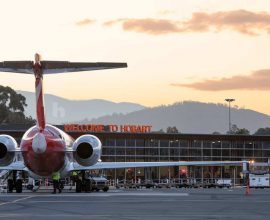Chinese New Year highlights tourism growth story
Australia’s airports have once again seen another busy Chinese New Year period, with a range of targeted activities to welcome this important market.
The Chinese visitor economy is now worth more than $10 billion and has grown significantly in recent times.
Major airports across Australia hosted in-terminal activations to support the influx of passengers during the popular Chinese New Year holiday period, ensuring the visitor experience got off to the best possible start as tourists touched down on Australian soil.
It’s an approach that’s been pursued by many Australian airports in recent years, with the growth of new services and carriers the proof of its success.
Sydney Airport has continued to introduce new Chinese services this year, following a strong year of growth in 2017. Its China ready strategy includes a range of initiatives, such as the introduction of Baidu Maps and Mandarin-speaking ambassadors, and has supported the strong growth of Chinese services at the airport in recent years.
Melbourne Airport also has a strong presence in the market, celebrating its 12th non-stop Chinese route in December – a Xiamen Airlines service to Hangzhou.
Brisbane Airport has also increased its offering for the Chinese market, most recently welcoming a new Beijing service in December. With Chinese language wayfinding across its terminals and a Chinese Liaison Officer on staff to support Chinese visitors, the airport continues to work in partnership with local tourism operators to grow this important market.
However, the interest in Australia as a destination is broader than the traditional hubs of Sydney, Melbourne and Brisbane.
Cairns Airport Chief Executive Officer Norris Carter says the current excitement about China is the result of airports working closely with tourism partners to sell the benefits of their regions and states.
“I think every airport – particularly the major gateway airports in Australia – have all played a part in attracting new Chinese carriers,” he said.
“There’s been a number of teams including airports, Tourism Australia, and representatives of all levels of government working together to attract Chinese carriers to our fabulous country.
“It’s been going on for a number of years and, at first, we saw some great growth during the Chinese New Year period.
“But now we’re seeing Chinese carriers come all year around, so all the work is paying off.”
Cairns Airport welcomed two new services in December 2017, China Southern’s service from Guangzhou and Hainan Airlines’ twice-weekly service from Shenzhen.
Mr Carter said the new services are the result of collaborative efforts to drive growth in the local visitor economy. Cairns Airport, Tourism Tropical North Queensland, Tourism Queensland, Tourism Australia and Cairns Regional Council all came together to support the China Southern service, while Cairns Airport and Tourism Queensland worked together to secure the Hainan service.
“In Cairns, the airport’s success is very closely aligned with tourism growth, so we work closely with those agencies to promote tourism and make new flights sustainable and successful. That’s a role the airport’s played over the last 10-20 years.”
AAA Chief Executive Officer Caroline Wilkie, the origins of the China tourism story dates back 20 years.
“The privatisation of Australia’s airports 20 years ago gave airports the opportunity to pursue international growth to benefit their local economies and communities,” Ms Wilkie said.
“This has allowed airports to go out to the world and identify opportunities for growth, and invest in airport improvements that make new routes viable.
“While our largest airports at Sydney and Melbourne have certainly had great success in attracting new Chinese carriers, the benefits have been far more wide-ranging than that – it’s a truly national story.”
On the west coast, China is the fifth largest international visitor market for Perth Airport, which has embarked on a dedicated strategy to attract more direct flights from Asia to the city.
It’s a move that’s not only expected to deliver tourism benefits to the country, but provide new trade opportunities for the state.
In fact, air freight is already creating new markets. The Geraldton Fisherman’s Cooperative has become the first Australia business to hold and own live seafood on Chinese soil.
The cooperative opened a warehouse and holding facility at Baiyun International Airport in Guangzhou in 2016, which is supplied from 80-tonne capacity saltwater lobster storage tanks located less than 10km from Perth Airport.
Ms Wilkie said this was a great example of trade opportunities made possible by air freight – and with about 80 per cent of air freight carried in the belly hold of passenger aircraft, tourism and trade went hand-in-hand.
“Airports are looking at the whole picture when putting a business case to international carriers to start a new service, and freight is inevitably an important part of that equation,” she said.
“The Perth example highlights the strong demand for air freight to and from China – and that’s something that can ultimately lead to new services delivering more value and choice for passengers, while also connecting economies.”





